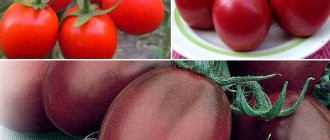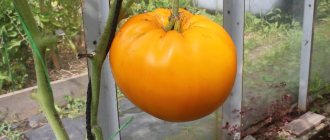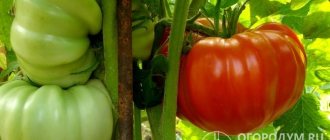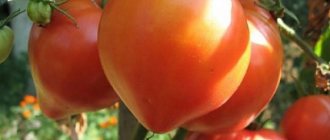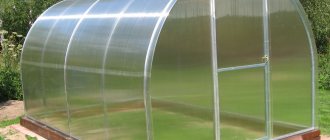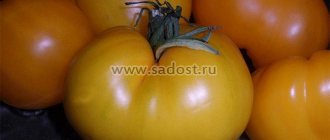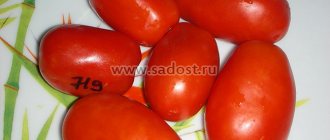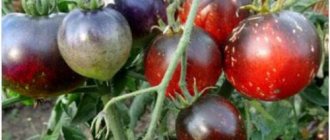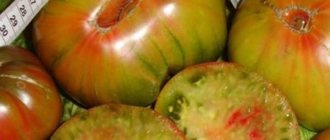Description of the Brandywine black tomato series and agricultural technology for growing the variety
The Brandywine black tomato is a new variety. During the growing season, a tall bush is formed that bears fruit abundantly. The Brandywine series includes tomatoes in dark red, pink, black, and yellow colors.
Advantages of variety varieties
The Brandywine black tomato series is a large-fruited variety with an average ripening period. From the moment of emergence of seedlings to fruiting, 90-110 days pass. The black coating of this genetically unstable variety can have different shades.
An indeterminate bush with pronounced potato leaves reaches a height of 1.8 m. During the growth process, it requires tying, removing stepsons, and forming 2-3 stems.
Description of fruits:
- The fruits have a flat-round shape, a rich crimson color with a brown tint.
- A ripe tomato has soft, creamy flesh, a sweet taste, and a fruity aroma.
- Its weight reaches 200-400 g.
- The fruits are not prone to cracking due to their thick skin.
- In cooking they are used fresh for making salads.
The American heritage variety Brandywine Red is one of the most popular in the United States. Tomato fruits are bright red in color, aromatic, and delicate in taste. The weight of a tomato is 220-450 g. During the growth process, tall bushes are formed, from which a good harvest is harvested.
The yellow Brandywine series tomato bears fruit in 120 days. The tomato is golden in color, flat, round in shape, weighing 300 g. When ripe, it does not crack on the plant. The variety is resistant to fungal diseases and tobacco mosaic virus.
The Brandywine pink series tomato ripens in 100-120 days. The height of the bush reaches 100-150 cm; It is recommended to plant in 1-2 stems. The weight of the fruit reaches 150-450 g. A ripe tomato is pink in color; when cut horizontally, 6 seed chambers are observed.
In cooking, the fruits of the Brandywine series are used fresh, to prepare tomato juice, as an ingredient for various dishes.
Agrotechnics of cultivation
Sowing seeds for seedlings is carried out to a depth of 2-3 mm in containers with prepared soil. After moistening the soil using a sprayer, cover the container with film. Seed germination time lasts 6-14 days.
For the appearance of friendly shoots, the seed material is first dipped into an aqueous solution of potassium permanganate. Uniform development of sprouts is ensured using optimal temperature conditions at +18… +23 °C.
For the normal formation of planting material, create maximum lighting and increase the length of the day to 16 hours using an electric lamp. During the entire growing season, mineral and organic fertilizers are applied.
In the phase of formation of 2 true leaves, the seedlings are planted in separate containers. For this purpose, it is better to take peat pots 7-10 cm deep. Their use allows you to preserve the root system from damage.
When the plants reach a height of 20 cm, they are transferred to open ground or a greenhouse to a permanent place. Tomatoes prefer maximum light, so it is recommended to plant them on the sunny side, in a place protected from the wind. The distance between bushes should be 45 cm.
To increase productivity and accelerate the ripening of tomatoes, the plant is regularly tied up, side shoots and lower leaves are removed. It is recommended to loosen the soil near the bushes, water them in a timely manner, remove weeds, and mulch with grass or non-woven black fiber.
Opinions and recommendations of gardeners
Reviews from vegetable growers cultivating Brandywine tomatoes indicate high yields and excellent taste of the fruit.
Anatoly Grigoriev, 49 years old, Krasnodar:
“I grew the yellow Brandywine tomato using seedlings. I purchased the seeds at a specialty store. To ensure the quality of the material, I conducted testing. I immersed the seeds in an aqueous solution of table salt.
Quality material always sinks to the bottom. I grew it in containers, planted it, and in mid-May I transferred it to the ground. The tall bushes with potato leaves had to be tied to a trellis.
The fruits are yellow in color, weighing 350-550 g, with a very pleasant fruity taste.”
Elena Samoilova, 56 years old, Kazan:
“In the Brandywine series, I drew attention to the dark variety of the variety. Last season I grew it in a greenhouse
The bush grew into 2 stems, and I got an excellent harvest of large and tasty tomatoes.”
- Ask a Question
- Choose a tomato variety
- Choose a variety of cucumbers
- Lunar calendar 2020
Characteristics and description of the Brandywine Black tomato with regular leaves
Those who love beef tomato varieties will be delighted with the Brandywine Black variety. This tomato variety is a hybrid of red Brandywine and black beef tomatoes. These hybrids may have potato-like leaves or regular leaves.
Let's learn about a variety with ordinary leaves.
Characteristics and description of the variety
The Brandywine Black variety is a medium-ripening hybrid. From germination to harvest it will take 110-120 days. The type of bush is indeterminate. The height of the bush is 180 cm, and when grown in closed ground it can be up to 220 cm. Designed for growing in open and closed ground. The bushes require pinching, staking and shaping.
The fruits are rounded and flattened in shape. The color is raspberry-brown, tinged with purple in places, and has a dark green tip around the stalk. The weight of the fruit varies from 250 to 500 grams. Inside the tomato there are from 6 to 9 chambers with seeds. The pulp is tender, but dense, juicy, creamy. The surface is glossy, slightly ribbed. The taste is very sweet. The smell is pronounced.
How to grow a tomato: technology
The new mid-season variety is able to withstand heat and cold without significant loss of yield. The bush will grow in the open air, but it is better to plant it in a greenhouse. We will consider a detailed algorithm for growing tomatoes below.
Planting in the soil
To get a high yield, you need healthy seedlings. Seeds are sown for seedlings 2-2.5 months before planting in a permanent place of growth. To do this, fill the boxes with prepared soil, moisten them with warm water and make grooves 1 cm deep.
Before placing it in the ground, it is better to treat the seed with a weak solution of potassium permanganate (1 g per 100 ml of warm water) for rapid germination and protection of plants from diseases. Place the prepared seeds in the soil to a depth of 1 cm, bury the grooves and cover the container with glass or film until the sprouts hatch.
The optimal air temperature for seedlings is +22…+25 °C. When the shoots appear, move the container to a well-lit place. With the appearance of 2 true leaves, we perform a dive. To do this, you will need separate pots filled with substrate.
Seedlings can be grown without transplanting. To do this, seeds are sown in peat pots or tablets. When one flower cluster appears on the seedling, it is transplanted to a permanent place of growth along with the container in which it was grown.
At the time of planting in open ground or a greenhouse, seedlings must have at least 5 formed leaves. To transplant seedlings, prepare holes in advance. We dig holes about 10 cm deep at a distance of about 0.5 m from each other. We put 20 g of wood ash at the bottom of the holes to disinfect the soil.
We place the seedlings in the hole and dig them in so that the lowest leaf is near the ground. The stems should be slightly inclined - this is necessary for their further painless formation.
For the successful development of the plant and a good harvest, the bushes will need to be fertilized. But not all fertilizers are suitable for Red Bugai tomatoes. We carry out this procedure as follows: at the flowering stage we add a composition that includes potassium. As the fruit sets, we use a product containing phosphorus, nitrogen and potassium, using all components in equal proportions.
When filling and reddening of the fruits, change the proportions:
- reduce phosphorus by half;
- increasing the potassium intake;
- reduce the amount of nitrogen by more than half.
Potassium increases the resistance of tomatoes to disease development.
Formation and support of plants
A month after planting, we remove the leaves in the lower area of the bush. We carry out the formation carefully. Leaves located above the 3rd peduncle cannot be removed. In order not to harm the culture, we carry out the procedure in several stages. This minimizes stress on the plant. To make fruit set better, shake the bushes in the morning.
We form plants into one or two stems. For proper formation, we adhere to the following rules:
- We wear gloves;
- We do not cut off very long or too short shoots;
- we break off the stepson at a distance of 1 cm from the stem;
- We pinch the breakage area without leaving any “wounds”.
For active growth of the crop, we tie the bush to a peg, otherwise it will break due to the large weight of the fruit. You can tie the plant to a stretched wire. We do this in the following way:
- We drive in several pegs on the sides and between the rows;
- stretch a strong wire;
- As the bush grows, we lift it and tie it up, doing this in two stems.
To obtain large fruits, do not forget to pay attention to the number of clusters. If a lot of ovaries form on the brush, it is also better to tie it up so that it does not break off or get damaged
Transplantation into the ground
The soil for planting is prepared in advance. Remove all weeds, apply fertilizer and dig thoroughly. Before planting, holes are prepared, 25-30 cm deep. Plants are planted according to the 60x50 pattern, that is, 3-4 plants per 1 meter. Do not water the soil before planting; this will compact it and the tomatoes will not grow well.
A support for fastening is placed in the hole along with the seedlings and sprinkled with earth. Water generously.
Watering is carried out daily. After the seedlings have taken root in the new location, watering is reduced to 2-3 times a week. And during the period of fruit filling, watering is resumed.
Plants are tied up as they grow. If the plants are too tall and begin to fall, then they need to be tied up. Form a bush with 2-3 stems. This will distribute the load from the fruit and increase the yield of the variety. The stepchildren remove everything, leaving 3 centimeter stumps.
The variety needs to be fertilized 4-5 times per season. The first fertilizer is applied a week after planting. The second - a month after landing. Third - during the flowering period of tomatoes. Fourth - during the period of fruit filling. Fifth - after harvesting the first stream of crops.
Definition of variety
These are pink tomatoes. They do not have an axial vine, but a number of successive shoots are often mistaken for it, in other words, exactly the stem that has the first inflorescence.
The bush turns out to be tall - up to 160 cm. It is this one that really causes criticism from vegetable growers, since if the plant is in a greenhouse, its upper part remains unused, and such expensive buildings must pay for themselves.
The leaves are small, potato-type, dull green in color, pubescent and smooth. The spreading of the plant is average.
Ripening occurs in stages, depending on the ripening time of the fruits, held in clusters located at different levels. Each cluster bears up to 4 fruits. Inflorescences are formed above the level of 9–12 leaves. The largest fruits are obtained only on the lower and middle inflorescences, and the higher they are, the smaller the tomatoes ripen. The peduncle has joints.
This variety is an early ripening variety; its ripening period lasts 80 to 100 days. Ripe tomatoes are pale pink, unripe ones are green, with a spot at the stem. As they ripen, they gradually turn into a varied pink pale shade, with a smooth thin surface. Flat-rounded, slight ribbedness at the base is noticeable. But in the lowest fruits the ribbing is more intensely expressed than in the upper ones. The fruits weigh from 250 to 450 grams.
The pulp is juicy and soft, sweet in taste, with a small number of seeds, multi-chambered. When broken, the juice does not flow out.
The current variety belongs to the salad variety, but tomatoes also make delicious juices, pastes, sauces and seasonings. But, if you have a marketable appearance, you should add an intense red color to the tomatoes; otherwise, the products will not attract buyers due to the pale shade.
Description of the tomato variety “Brandy pink”
The brandy pink tomato variety has mixed reviews and reviews from gardeners who have already harvested these tomatoes. Let's figure out what the advantages and disadvantages of the variety are.
general characteristics
There is an assumption that the variety was created on the basis of the American “brandywine” tomato, which has several varieties with fruits of yellow, pink, red and black, which is reflected in the names of the varieties, for example, black or apricot “brandywine”.
Ask and receive useful advice from professional gardeners and experienced summer residents.>>
The domestic version of the “brandy” tomato is recommended to be grown in central Russia in greenhouses. In the south it bears fruit excellently in open ground.
The variety belongs to the indeterminate class. However, growing experience has shown that the bush, having reached a height of 1.7 m, stops growing, and gardeners do not really like this. After all, tomatoes that can grow up to 3 m are most often planted in greenhouses. And, nevertheless, even though the plant is not very tall, like the apricot “Brandywine” tomato, it needs staking and bush formation.
The foliage is shaped like potato tops. It has a smooth surface and dark green color. According to the description of the originator, the foliage of the bushes is moderate.
Fruit
The variety belongs to the mid-season category, which means that the first fruits can be harvested 110-115 days after emergence.
The ripening of tomatoes is unfriendly, extended over time depending on weather conditions.
The first inflorescence appears on the stems at the level of 8-10 leaves. No more than 4 ovaries are formed in the hand. The largest fruits grow up to 450g, but this is rather an exception to the rule. Most tomatoes weigh between 150 and 250g.
Despite the fact that the yield is considered quite good, you need to know that with a lack of moisture, tomatoes begin to actively ripen without reaching large sizes. If watering is insufficient during the formation of the ovaries, then most of them will fall off.
With proper care, you can collect 5-6 kg of fruit from one bush.
The shape of the fruit is round and slightly flattened, with a slight rib at the stalk. The color is pink with a shade lighter than, for example, the Beef Pink Brandy f1 hybrid. The pulp is juicy with a small amount of seeds. Many gardeners rated the taste qualities as high for their sweet taste and delicate aroma. The skin of the fruit is thin but dense.
Usage
Tomatoes of this variety are tasty not only fresh, but are also actively used for culinary processing. They make excellent ketchups, condiments, and sauces. They are also suitable for making tomato paste and juice.
Preserving them is problematic, because the smallest fruits can fit in jars, and not many of them are formed on the bush.
Features of cultivation
The time for sowing seeds is selected taking into account the local climate: 60 days before planting in the ground. You can plant the sprouts in separate cups when they have formed two true leaves.
When transplanting into a greenhouse or outdoor garden bed, the placement density must be observed: 3 plants per 1 m2.
After each watering, and it should be moderate, you need to loosen the soil and periodically hill up the tomatoes, improving the nutrition of the roots with useful substances.
In order to ensure good air circulation under the bushes, it is better to tear off the lower leaves on the stems up to the first cluster. This technique will also reduce the likelihood of plants becoming infected with late blight.
Ideal conditions for growing are air temperature 22-25°C and humidity 70%. It is not difficult to create such conditions in a greenhouse. The main thing is not to forget to ventilate it regularly.
Tomatoes need regular feeding. The soil under them needs to be enriched with complex mineral fertilizers every three weeks.
Diseases
The “Brandy Pink” variety is resistant to diseases, but there is still a possibility of plants being damaged by fungal diseases. This happens solely due to a careless attitude to the rules of care.
To protect tomatoes, it is necessary to apply simple preventive measures:
- Disinfection of seed and soil with a weak solution of manganese.
- Add one tablespoon of sifted wood ash to each hole before planting the seedlings.
- Treatment of plants with the systemic drug “Fitosporin-M”.
Gardeners write good reviews about “brandy pink” tomatoes. For those who have never grown this variety before, there is a great opportunity to try planting it in your greenhouse and add to your collection of your favorite tomatoes.
Unusual and very tasty - Brandywine Black tomato: description of the variety
The original name of the variety is Black Brandywine. The black-fruited tomato comes from the USA and is loved to be grown throughout the post-Soviet space. The variety is divided into three subspecies, but in Russia they all come out under the same name - “Black Brandywine”.
| Height | Landing location | Ripening time | Fruit color | Fruit size | Origin | Fruit shape |
| Tall | Greenhouse, Open ground | Mid-season | Black | Large | Hybrid | Flat-round |
Description and characteristics of the variety
The tomato has an interesting history: it is believed that two subspecies were bred by crossing the red-fruited “Brandywine” with black-fruited beef tomatoes, and the third was bred by G. Martin in the early 20s of the last century. However, these versions do not have sufficient evidence. In any case, these tomatoes have in common an almost identical taste and the earliest ripening time among black tomatoes.
Black brandywine is an indeterminate plant; growth varies depending on the location and subspecies from 1.2 to 2 meters. The stem is powerful, the inflorescences are formed by 2-5 tomatoes. The tomatoes are large, on average 250-500 grams, with up to 9 chambers with seeds inside. The pulp is very tender both in feel and taste, but quite dense and holds its shape well when sliced. The ribbing is most pronounced in tomatoes of subspecies 1 and 3.
Advantages and disadvantages
- large fruit;
- balanced taste;
- rich aroma of tomatoes;
- potentially high yield;
- can be used for making juices, especially good in salads;
- transportable;
- rarely gets sick.
Minuses:
- high growth complicates plant care;
- the bushes actively produce stepchildren, which must be removed regularly;
- tomatoes require shaping and staking;
- the largest fruits sometimes crack when ripe.
Productivity
The variety is considered high-yielding. With proper care and feeding it produces up to 8 kg of tomatoes per plant. The quantity and taste of fruits is influenced by the growing method - greenhouse or open ground, and the number of sunny days per season.
Features of cultivation and storage
Based on reviews from experienced gardeners, it is worth noting that tomato seeds have good germination up to 80%. They have high growth energy. The bush can be formed into 2-3 stems. This technique is used to increase the yield by planting more ovaries. The root system is well developed, but it cannot fully supply the fruiting plant with nutrients.
Keeping quality is average, the variety is not intended for long-term storage. Quick processing into sauces, juices, pastes or ketchups is much more effective.
Planting and care
Sow tomatoes in prepared containers with loose, breathable soil. You will have to wait about two weeks for germination. Young sprouts need to maintain temperature conditions, the optimal development temperature is from +18 to +23 ° C and daylight hours (supported by lamps) for up to 16 hours.
When the seedlings are strong enough and the frosts have subsided, the tomatoes can be planted in a permanent place. The soil in the beds should be warm, loose, nutritious, but with a lower nitrogen content.
Caring for tomatoes is systematic and requires frequent human presence.
- Once every 7-10 days it is necessary to remove excess foliage and tie up the plants. When pinching stepsons, you need to leave a small stump.
- Tomatoes need quite a lot of moisture, but it is better to water them with a small amount of water and more often. A large amount of water applied once a week will cause the tomatoes to crack.
- To form large fruits, tomatoes must be fertilized. Feeding is carried out 4-5 times per season.
- Periodically inspect foliage, stems, and fruits for infection or parasites. Carry out preventive treatments.
Tomato Brandywine black or Brandywine Black
| Fruit color | Ripening time | Growing method | ||||||
| Black Brandywine (reg. sheet) | Black Brandywine (potato leaf) | Real Black Brandywine (potato leaf) | Black Brandywine (reg. sheet) | Black Brandywine (potato leaf) | Real Black Brandywine (potato leaf) | Black Brandywine (reg. sheet) | Black Brandywine (potato leaf) | Real Black Brandywine (potato leaf) |
| red-brown with purple tint | purple-black | brown-black | early (approx. 80 days) | mid-early (approx. 90 days) | mid-early 80-90 days | preferable in a greenhouse, but also acceptable in open ground | ||
Black Brandywine is a genetically unstable variety or a whole group of individual hybrids of red Brandywine and unknown black beef tomatoes. In addition to the color and size of the fruit, the subspecies of Black Brandywine also differ in the shape of the leaves: it can be either typical for tomatoes (regular) or similar to the shape of potato leaves. But Black Brandywines also have a common feature: when exposed to direct sunlight, the fruits acquire green “shoulders” (they can darken over time and can be smooth or ribbed).
All Black Brandywines are productive indeterminates. When grown in a greenhouse, the height varies from 1.2 m to 2.1 m, in open ground - up to 1.6 m. Fruit weight is 220-500 g; Large fruits sometimes crack.
| Black Brandywine (reg. sheet) | Black Brandywine (potato leaf) | Real Black Brandywine (potato leaf) |
| 250-500 g | 220-350 g | 300-500 g |
Not much is known about the origin of the variety: it is believed that Black Brandywines (reg. and potato) are natural hybrids, and True Black Brandywine was bred artificially in the late 20s of the last century by Dr. G.E. Martin; but this version did not find sufficient confirmation.
In the post-Soviet space, all three varieties of Black Brandywine are called by the same name (and, accordingly, distributed under the same name). In any case, they have similar taste qualities and are one of the earliest black chokeberry varieties.
1st and 3rd Brandywines (from the table) are typical representatives of “beefsteak tomatoes”:
- large, flat-round;
- with tender (but dense) creamy pulp;
- sweet, with a pronounced aroma, rich in nutrients;
- suitable for consumption raw and any type of processing (sauces, frying, baking, canning whole or in slices).
The 2nd Brandywine has medium-sized fruits that are more rounded and juicier. They contain more seeds, but are also very tasty.
Diseases
The “Brandy Pink” variety is resistant to diseases, but there is still a possibility of plants being damaged by fungal diseases. This happens solely due to a careless attitude to the rules of care.
To protect tomatoes, it is necessary to apply simple preventive measures:
- Disinfection of seed and soil with a weak solution of manganese.
- Add one tablespoon of sifted wood ash to each hole before planting the seedlings.
- Treatment of plants with the systemic drug “Fitosporin-M”.
Tomato “Brandy pink”: details about its advantages and disadvantages
Tomato “Brandy pink” characteristics and description of the variety, yield, reviews are not clear. It's all because of those seed packers who, by printing information on the bags, slightly add beauty to the fruits and the yield of the entire plant. Vegetable growers who expect to get a return have a negative opinion about the variety as a whole, but by the way, you need to figure it out.
general information
An application for inclusion in the register of selection achievements was submitted by Agrofirm Poisk LLC, Moscow region, Russia in 2013. After undergoing variety testing for two years, in 2015 the variety was entered into the register under number 8653771.
Characteristics and description
In addition, reviews from vegetable growers indicate that the variety produces a good, large, marketable tomato only on the lower and middle inflorescences, and the higher it is, the smaller it becomes.
The variety is mid-season, intended for salad purposes, and this is another minus. The fact is that by the time “Brandy Rose” ripens, salad tomatoes, early and tasty, have already been tasted by experienced vegetable growers, and they are still in the midst of the growing season, and the arrival of the next salad seems to be too much.
The tomato leaf plate is small, green, without color intensity. Tomato stalk with articulation. The inflorescence is simple, not racemose. Fruit set on each cluster is 3-4.
An unripe green tomato with a spot at the stalk. As it ripens, the greenery disappears and the fruit turns pink. The color of the tomato cannot be called intense and uniform; it is slightly pale.
The tomato is average in density, although there are reviews from vegetable growers that it is a little soft and does not correspond to the stated characteristics. There are 6 or more nests in a tomato, they are filled with pulp and seeds. There is no leakage of juice when cut.
Productivity
The market is overflowing with excellent high-yielding tomatoes that will ensure high profitability of the greenhouse, so for this variety this indicator is considered a disadvantage.
Marketability and shelf life
On this basis, the variety also does not reach the standard. Considering that the ripening of the fruits does not proceed smoothly, they are of different sizes, although they have already fully reached commercial ripeness, it is not possible to collect a large harvest overnight.
The keeping quality of the variety is also not great. After harvesting, it soon begins to soften and becomes unsuitable even for preparing salads.
Surplus products can be well used for preparing tomato products, sauces, ketchups, and tomato juice. However, given that the tomato is pale in color, the products require the addition of red varieties, otherwise these tomato products will not be marketable.
Resistance to diseases and pests
The variety registry submits a variety with legal resistance to the tobacco mosaic virus. The relationship of the variety to other diseases is silent. However, experienced vegetable growers who grow tomatoes in greenhouses from year to year argue that when growing the “Brandy Pink” variety, preventive treatments with fungicidal preparations cannot be abandoned.
- low yield;
- low texture density;
- low product yield;
- greenhouse not full.
Features of growing the variety
A tall plant that has a fruit of 100 grams or more requires shaping and gartering.
Seeds for seedlings are sown in early March. In the state of two true leaves, the seedlings are planted in disposable cups with a capacity of 200-250 g. If universal seedling soil is used for planting, then no additional fertilizing is carried out during the growing period.
For indeterminate tomatoes, a well-developed, deep root system is very important. To grow it with optimal performance, it is necessary to transfer the seedlings into a larger container. This event is carried out when the roots completely master the earthen ball.
If the seedlings are stretched, then they are transplanted lying down, which is even more desirable, since the area of root nutrition increases.
When choosing a variety for growing in greenhouses and greenhouses, it is better to give preference not only to a pink-fruited and tasty variety, but also to a super productive variety or hybrid. In order for a greenhouse to grow profitable products, it is necessary to strictly follow agrotechnical instructions, maintain water balance and nutritional value, and fertilize.
Advantages and disadvantages
Pros:
- large fruit;
- balanced taste;
- rich aroma of tomatoes;
- potentially high yield;
- can be used for making juices, especially good in salads;
- transportable;
- rarely gets sick.
Minuses:
- high growth complicates plant care;
- the bushes actively produce stepchildren, which must be removed regularly;
- tomatoes require shaping and staking;
- the largest fruits sometimes crack when ripe.
Brandywine tomato black, yellow, pink and red: description of varieties with photos
The Brandywine tomato is a relatively new tomato variety. Its main distinguishing feature is the color of the fruits, which have a dark red or black coating. Before you start growing such a tomato, you need to familiarize yourself with its description and characteristics.
Short description
Brandywine red and black are mid-season tomatoes that fully ripen two months after young seedlings are planted in the ground. The tomato has fairly tall bushes, which under optimal conditions can grow up to two meters.
Because of this, the bushes often break and begin to dry out. To get rid of this problem, during cultivation you should tie them to pre-installed supports made of wood or iron. Also, the bushes require mandatory pinching.
To obtain maximum yield, you should form a tomato into several stems.
The fruits of the plant have a flat-round shape and are colored dark red. In some varieties, after ripening, the color turns yellow or the skin simply acquires a slight yellow tint.
The weight of tomatoes is considerable - 250-500 grams. When grown in greenhouses, you can get a larger harvest. This variety is most often used for preparing fresh vegetable salads.
However, in some cases it is used to prepare tomato juice.
Planting seeds
It is recommended to plant the pink Brandywine tomato variety for growing seedlings in early spring, two months before planting in open ground. The process of sowing seeds to obtain seedlings is carried out in several stages.
Preparation of planting material
It is recommended to use only the highest quality seeds for planting. To select them, you need to use a saline solution. To do this, pour a liter of water and 100 g of salt into a small container. Then everything is thoroughly mixed and seeds are added to the liquid.
In just five minutes, some of them will begin to float to the surface. It is them that you will have to get rid of immediately, since they are empty. All other seeds are removed from the container and dried.
Landing
To grow seedlings, special boxes filled with soil are used. First, you should make several small holes in the ground no larger than two centimeters in size. Then 1-2 seeds are added to each hole and covered with soil. Also, after planting, you should water the soil and cover the containers with tomatoes with plastic wrap.
Bushes should be grown in a lighted room with an air temperature of at least 25 degrees. In order for seedlings to grow better, you should take care of their daylight hours, which should not be less than 15 hours.
Planting seedlings
Seedlings are planted in the garden in the last month of spring after the night frosts have ended. If you start replanting it too early, the tomatoes may not cope with the low temperature.
Soil preparation
To accelerate the growth of seedlings, you should properly prepare the soil for planting. Therefore, it is recommended to apply all necessary fertilizers to the site in advance. Even in the fall, the soil is fed with river sand and peat. It should also be watered with a nutrient solution containing potassium with superphosphate. Some vegetable growers add humus and turf ash to the soil.
In addition, the area must be completely dug up so that the soil is not too dense. Some gardeners water the soil before planting, but this should not be done, as this will cause a dense crust to appear on the surface of the soil.
Conclusion
Even a gardener who has never grown vegetables before can grow Brandywine. To do this, just read the recommendations for planting this variety and look at the reviews of people who have planted it in their garden more than once.
Features of cultivation
Spring is a wonderful time for planting. Then, after 3 - 3.5 weeks, you can plant young, tender bushes in open ground. In the complete planting process, the main stages can be distinguished:
Preparing seed material
High-quality seeds are the key to healthy and strong seedlings. The germination rate of the seeds is about 80% of all that is contained in the pack - this is the conclusion of Russian summer residents. To improve the quality yourself, you can start by choosing the best seeds, thus:
- Dilute 90 - 95 g of salt in 1 liter of warm water and stir until dissolved;
- Place the seeds in water and leave them for 10 minutes;
- Those seeds that float are not suitable, as they are hollow. Keep only those that have drowned.
Planting seedlings
We sow seeds for seedlings 2 months before their intended planting. We prepare compact boxes and fill them with soil. We make small depressions in the soil - no more than 2 cm. Place 2 seeds in each hole. Then, water well for good and fast germination. Cover the boxes with film or a plastic bag and place them in a place well lit by the sun. Good lighting should be provided at least 14 hours a day. Maintain a stable room temperature for favorable seedling growth of + 21 - + 25 degrees.
Preparing the soil for planting in the ground
Good soil quality is necessary for the growth of “green mass” of bushes. Therefore, we apply all fertilizers in advance. In established spring weather, add peat and sand to the soil. We feed with a nutrient solution containing potassium and phosphorus. It is also possible to add humus and ash. Immediately before planting the tomato, dig up the intended planting site well, removing all weeds, but do not water it so that a soil crust does not form.
Planting in open ground
In the spring, when the frosts stop, you can grow Brandywine Black in an open garden bed. Do not plant too early, otherwise the plant may not withstand the low temperature and will die. When planting seedlings, place on 1 square. m no more than 4 plants. For good yield, form a bush with 2 - 3 stems.
Care
Regular watering is necessary. Once the seedlings take root, watering can be reduced to several times a week. And as soon as fruiting begins, it is recommended to resume the frequency again.
It is better to tie it as the bush sprouts. Stepchildren should be removed, leaving stumps 2 - 3.5 cm deep.
Otherwise, it is enough to loosen and remove weeds in a timely manner. Tomato does not require complex care.
Description of the tomato variety “Brandy pink”
The brandy pink tomato variety has mixed reviews and reviews from gardeners who have already harvested these tomatoes. Let's figure out what the advantages and disadvantages of the variety are.
general characteristics
There is an assumption that the variety was created on the basis of the American “brandywine” tomato, which has several varieties with fruits of yellow, pink, red and black, which is reflected in the names of the varieties, for example, black or apricot “brandywine”.
Ask and receive useful advice from professional gardeners and experienced summer residents.>>
The domestic version of the “brandy” tomato is recommended to be grown in central Russia in greenhouses. In the south it bears fruit excellently in open ground.
The variety belongs to the indeterminate class. However, growing experience has shown that the bush, having reached a height of 1.7 m, stops growing, and gardeners do not really like this. After all, tomatoes that can grow up to 3 m are most often planted in greenhouses. And, nevertheless, even though the plant is not very tall, like the apricot “Brandywine” tomato, it needs staking and bush formation.
The foliage is shaped like potato tops. It has a smooth surface and dark green color. According to the description of the originator, the foliage of the bushes is moderate.
Fruit
The variety belongs to the mid-season category, which means that the first fruits can be harvested 110-115 days after emergence.
The ripening of tomatoes is unfriendly, extended over time depending on weather conditions.
The first inflorescence appears on the stems at the level of 8-10 leaves. No more than 4 ovaries are formed in the hand. The largest fruits grow up to 450g, but this is rather an exception to the rule. Most tomatoes weigh between 150 and 250g.
Despite the fact that the yield is considered quite good, you need to know that with a lack of moisture, tomatoes begin to actively ripen without reaching large sizes. If watering is insufficient during the formation of the ovaries, then most of them will fall off.
With proper care, you can collect 5-6 kg of fruit from one bush.
The shape of the fruit is round and slightly flattened, with a slight rib at the stalk. The color is pink with a shade lighter than, for example, the Beef Pink Brandy f1 hybrid. The pulp is juicy with a small amount of seeds. Many gardeners rated the taste qualities as high for their sweet taste and delicate aroma. The skin of the fruit is thin but dense.
Usage
Tomatoes of this variety are tasty not only fresh, but are also actively used for culinary processing. They make excellent ketchups, condiments, and sauces. They are also suitable for making tomato paste and juice.
Preserving them is problematic, because the smallest fruits can fit in jars, and not many of them are formed on the bush.
Features of cultivation
The time for sowing seeds is selected taking into account the local climate: 60 days before planting in the ground. You can plant the sprouts in separate cups when they have formed two true leaves.
When transplanting into a greenhouse or outdoor garden bed, the placement density must be observed: 3 plants per 1 m2.
After each watering, and it should be moderate, you need to loosen the soil and periodically hill up the tomatoes, improving the nutrition of the roots with useful substances.
In order to ensure good air circulation under the bushes, it is better to tear off the lower leaves on the stems up to the first cluster. This technique will also reduce the likelihood of plants becoming infected with late blight.
Ideal conditions for growing are air temperature 22-25°C and humidity 70%. It is not difficult to create such conditions in a greenhouse. The main thing is not to forget to ventilate it regularly.
Tomatoes need regular feeding. The soil under them needs to be enriched with complex mineral fertilizers every three weeks.
Diseases
The “Brandy Pink” variety is resistant to diseases, but there is still a possibility of plants being damaged by fungal diseases. This happens solely due to a careless attitude to the rules of care.
To protect tomatoes, it is necessary to apply simple preventive measures:
- Disinfection of seed and soil with a weak solution of manganese.
- Add one tablespoon of sifted wood ash to each hole before planting the seedlings.
- Treatment of plants with the systemic drug “Fitosporin-M”.
Gardeners write good reviews about “brandy pink” tomatoes. For those who have never grown this variety before, there is a great opportunity to try planting it in your greenhouse and add to your collection of your favorite tomatoes.
VIP Tomato
580. Mrs. Benson - medium/ripe, up to 1.8 m, indet, large pink beef, up to 500 g, super grade
581. Tuscan Plombino - tall, medium/ripe, fruits over 500 grams, red with watermelon pulp. Super grade
582. Polina - 1.8 m., medium/ripe indet, raspberry fruits up to 500 g, sweet, fleshy, fruitful
583. Heart of Mordovia - very large raspberry hearts, fleshy, variety up to 1.8m, medium/ripe indet
584. Collective farm - 1.8 m., medium/early, productive, fruits are flat-round, pink-red, up to 500 g, fleshy, tasty - finished
585. Confederate - up to 1.8 m, medium/ripe indet, beautiful pink beef, with a delicious sweet taste
586. Big red Franka - medium/ripe, 1.8 m., indet, up to 800 g, round raspberry fruits
587. Mount Athos - 1.8 m, medium/ripe indet, red plump hearts, sometimes double, tasty, more than 300 gr.
588. Delicious hunting - 1.8 m, medium/ripe indet, up to 900 g, pink, powerful, fleshy. Super variety!
589. Bulgarian rose - 1.8 m, medium/ripe indet, up to 500 g, the top looks like the petals of a strange flower, productive
590. Sugar heart-sr/ripe indet, up to 1.7 m, fruits up to 400 g, heart-shaped, red, very productive variety
591. Mother Russia - medium/early, 1.6 m indet, pink flat-round fruits with slight ribbing, up to 600 g
592. Ukrainian pink giant - up to 2 m, indet, pink flat-round fruits, large, up to 1 kg, tasty
593. Red sunset horizon - 1.8 m, early, red round-heart-shaped fruits 300-600 g, tasty, fleshy
594. Sweet Li - 1.8 m, medium/early indet, fruits are raspberry pink, flat-round, up to 400 g, sweet, fleshy
595. Marmande de Montpeliser (Marmande from Montpellier) - red with gold stripes, up to 800 g, productive up to 1.8 m - out
596. Zurab Kukhianidze variety - low, semi-rounded fruits, red up to 400 g, sweet, productive variety
597. King King 2 - 1.6 m. indet, pink, heart-shaped fruits, fleshy, productive variety - out of stock
598. Pink vintage - medium/ripe, 1.8 m. indet, pink, flat-round fruits, 500 g or more, excellent taste
599. King of the Giants - medium/ripe, 1.8 m. indet, flat-round fruits, red with yellow stripes, up to 500 g
600. Aburida - medium/ripe indet, huge plums, about 300 g, red, tasty, productive variety. Ended
601. Astrakhan giant - medium/early indet, large raspberry fruits up to 700 g, productive, delicious variety
602. Bulgarian challah - 1.8 m indet, flat-round, up to 800 g, slightly ribbed, pink, shelf-stable, sweet
603. MagoMord
604. Bear's paw - 1.8 m, medium/early indet, red, flat-rounded fruits with pronounced ribbing, up to 800 g
605. Pink pipes - up to 1.7 m. indet, medium/ripe, pink beef, up to 500 g, delicious
606. Heat - medium/ripe, 1.8 m. indet, dense, bright, red, semi-rounded fruits, up to 700 g, fruitful, sweet
607. Akers West Virginia - 2.2 m, strong indet, red flat-round fruits up to 500 g, tasty
608. Brandywine pink - ancient, medium/ripe indet, flat-round, pink, up to 450 g, delicious
609. Brandy pink - medium/ripe, up to 450 g indet, flat-round, slightly ribbed, pink, sweet fruits
610. Knight's helmet - early, up to 1.5 m. indet, heart-shaped, pink fruits, 200-600 g, fleshy, sweet
611. Sweet beefsteak - 1.6 m, medium/ripe indet, fruits are flat-round, slightly ribbed, up to 400 g, sweet
612. 42 days - early up to 50 g, red, fruits are round or with a small spout, compact bushes, for northern regions
613. Boondocks - 1.8 m indet, flat-round fruits, pink, up to 700 g, tasty, aromatic
614. African liana - medium/ripe, 1.8 m indet, heart-shaped fruits, pink, up to 300 g, fleshy, sweet
615. George Detsika * sItalian Red (George Detsika’s Italian red) - red fruits up to 450 g, tall, medium/ripe indet
616. Regina - 1.8 m medium/ripe indet, flat-round, crimson with slight ribbing, up to 500 g
617. Hanging paste Lattanzio - medium/ripe, 1.8 m. indet, fruits are elongated, fleshy, collected in clusters, an old family variety from Italy
618. Red Beauty - red, meaty beef with yellow stripes and splashes, flat-round, up to 300 g
619. Mong - 1.8 m medium/ripe indet, huge red blunt hearts, with a fruity aroma, fleshy, over 800 g
620. Dendrera - early, 1.6 m, up to 200 g, beautiful pink pear fruits, dense, sweet, for canning
621. Pink goose egg - 1.8 m, powerful bushes, complex cluster, up to 300 g, pink fruits, very productive variety. Ended
622. Kaleidoscope - children, up to 110 cm, cherry, round, dark red, tasty, for children's diet food
623. Brandy wine medium/ripe, up to 450 g indet, flat-round, slightly ribbed, brown, sweet fruits
624. Donskie - medium tall, up to 1.8 m, pink, strewn with sweet fruits up to 200 g, productive variety
625. Heart of the capital - 1.8 m indet, flattened heart, up to 400 g, dark red, solid pulp
626. Hollydays Mortgage Lifter - indet, medium ripe, raspberry-pink beefs, resistant to cracking, 250-500 g, flat-round, sets well in cold summers, strong bush
627. Shebaigan - medium/ripe indet, raspberry fruits, elongated plum hearts, up to 200 g, dense, sweet
628. Brandywine Glick * sstrain (Brandywine Glick) - up to 1.8 m indet, pink fruits with a raspberry tint, up to 350 g
629. Hotly beloved red Bulgarian - 1.8 m, medium/ripe, red fruits, tasty up to 500 g
Catalog numbers (continued on other pages)
30-79 80-129 130-179 180-229 230-279 280-329 330-379 380-429 430-479 480-529 530-579 580-629 630-679 680-699 1500-1549 1550-1579
Planting seeds
Preparation of planting material
It is recommended to use only the highest quality seeds for planting. To select them, you need to use a saline solution. To do this, pour a liter of water and 100 g of salt into a small container. Then everything is thoroughly mixed and seeds are added to the liquid.
Description of the tomato variety Ballerina and its characteristicsRead
In just five minutes, some of them will begin to float to the surface. It is them that you will have to get rid of immediately, since they are empty. All other seeds are removed from the container and dried.
Landing
To grow seedlings, special boxes filled with soil are used. First, you should make several small holes in the ground no larger than two centimeters in size. Then 1-2 seeds are added to each hole and covered with soil. Also, after planting, you should water the soil and cover the containers with tomatoes with plastic wrap.
Bushes should be grown in a lighted room with an air temperature of at least 25 degrees. In order for seedlings to grow better, you should take care of their daylight hours, which should not be less than 15 hours.
